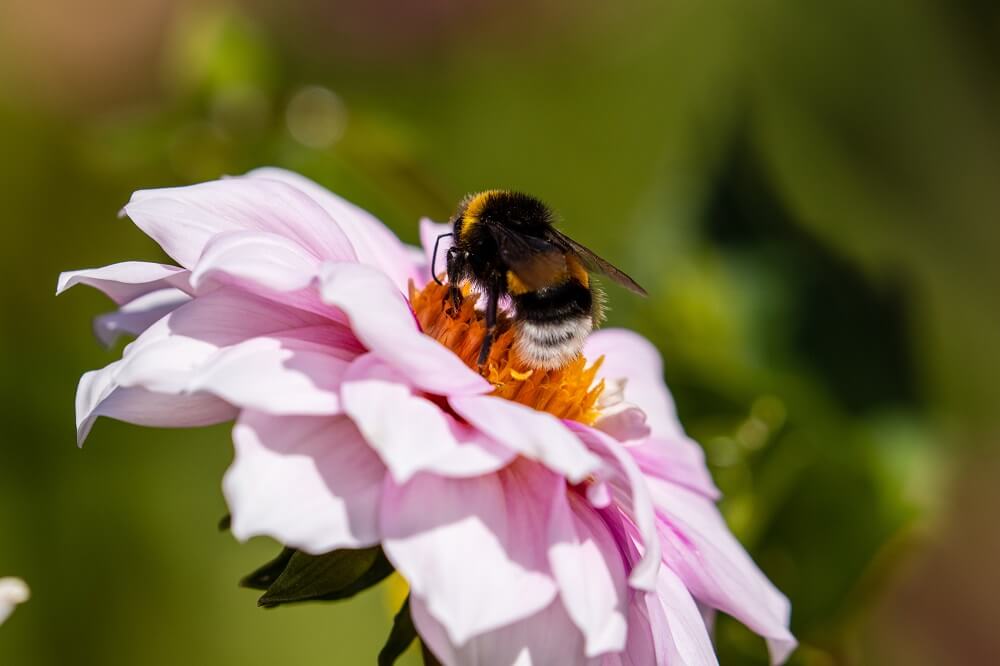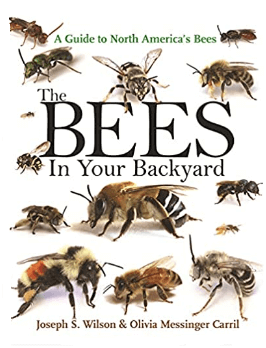Do Bees Have Lungs?
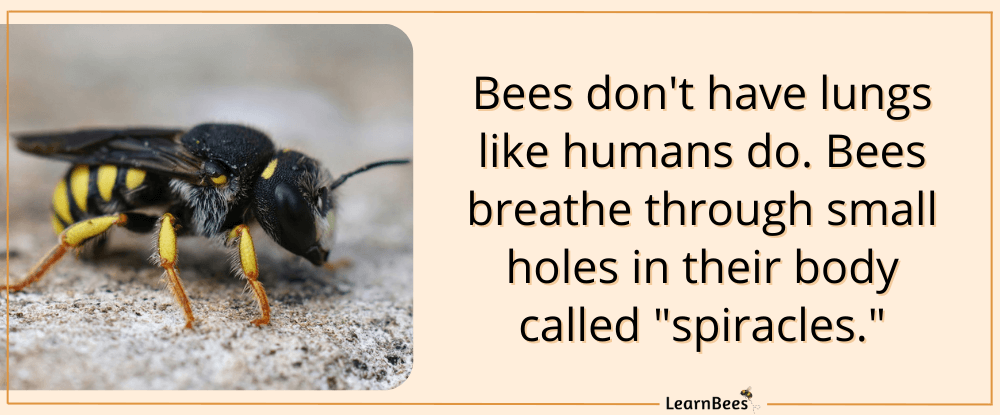
Short answer:
No, bees don’t have lungs. But, like other animals, bees still need oxygen to survive.
Now you might wonder: Well, how do bees breathe without lungs?
Instead of lungs, bees breathe through small holes called “spiracles.”(1, 2)
Long answer:
Bees breathe through holes called spiracles. Spiracles are ten small holes found on a bee’s abdomen and thorax.(1, 2)
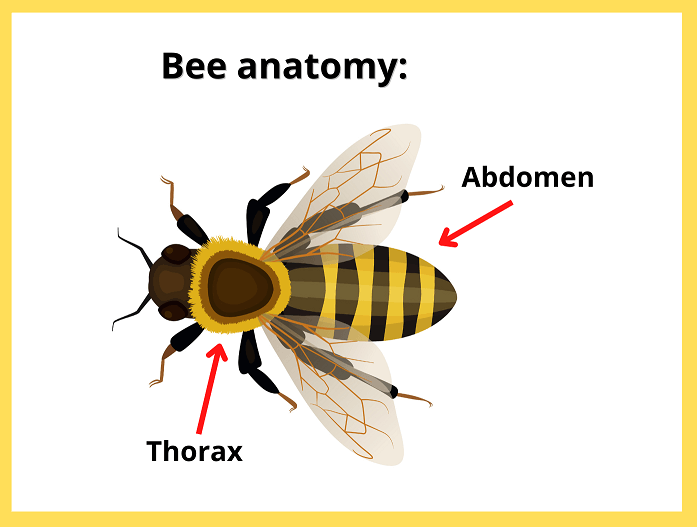
How do spiracles work?
To put it simply, these holes allow air to come in and out. When bees relax their abdominal muscles, air comes in through the spiracle holes. When bees contract their abdominal muscles, air goes out.(3)
But here’s the thing:
Spiracles are one-way holes. This means spiracles can’t let air in and out at the same time. Much like how humans can’t breathe air in and out at the same time.
With that in mind:
Spiracles are just one part of a bee’s respiratory system. So now the question becomes…
How Do Bees Breathe?
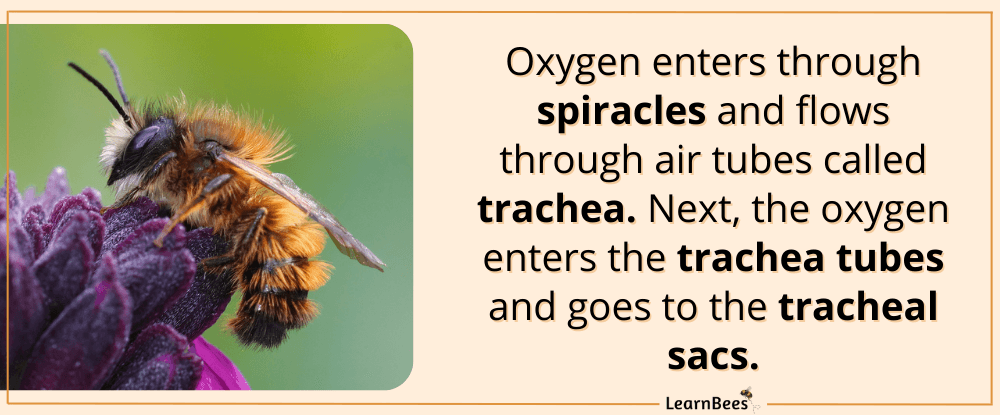
Once oxygen enters through spiracles, it passes through air tubes called trachea. From there, the oxygen flows through the trachea tubes into air sacs called tracheal sacs.(4, 5, 6)
In a nutshell?
- Oxygen enters through 10 holes (spiracles)
- Oxygen passes through air tubes (trachea)
- Oxygen reaches air sacs (tracheal sacs)
And that’s it.
That’s how bees breathe.
Can Bees Breathe Underwater?
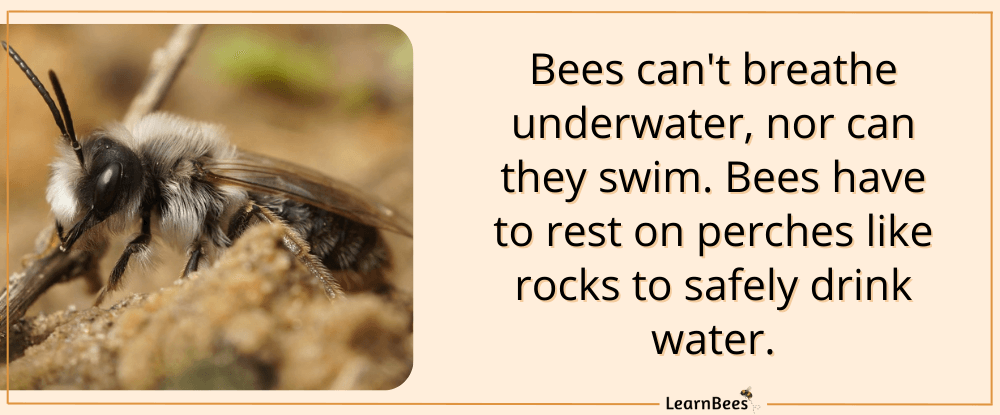
People often ask, “How do bees breathe underwater?”
The answer?
They can’t.
In fact, bees can’t even swim. A bee’s wings don’t offer as much movement as humans’ arms and legs do. Also, water weighs down a bee’s body and wings, which prevents them from flying away.
So what do bees do when they’re stuck in water?
They attempt a technique called hydrofoiling. Hydrofoiling is when bees create a wave in the water that allows them to “surf” toward the dry ground.
A bee that’s hydrofoiling can usually last for about 10 minutes. Meaning, they’ll drown if they don’t reach dry land in 10 minutes.
So if you see a bee in water, give her a “leg up” to safety. Grab a leaf or another object to scoop her up. Then put her in direct sunlight to warm up and dry out. Additionally, it’s best to place the bee near flowers.
But what if you don’t have flowers nearby?
You can also offer her a sugar-water mixture to help restore her energy. Mix one tablespoon of regular white sugar with one tablespoon of warm water. Stir the mixture together until the sugar dissolves.
Finally, allow the mixture to cool to room temperature before putting it near the bee.
But remember:
Bees can’t swim, so keep the sugar water in a shallow spoon or plate.
If the bee doesn’t move after an hour or longer, you can offer her a night of safe rest. Start by poking small holes into a shoebox for ventilation. Next, store the bee in the box for a single night. When morning comes, place the open box in the sun and allow her to fly out when she’s ready.
Keep in mind:
Poking holes in the box are crucial so the bee can breathe. Also, don’t forget to release her as soon as possible the following day.
FAQs about “Do Bees Have Lungs?”
- Do bees need both oxygen and carbon dioxide?
- Why do bees have no lungs?
- Can bees suffocate?
- Do bees give us oxygen?
- What are spiracles?
- What is a trachea?
- What are tracheal sacs?
- What is a tracheal mite?
- Do other insects have lungs?
- How does a bee’s respiratory system differ from humans?
- Do bees control their breathing?
- Do bees breathe through their skin?
Do bees need both oxygen and carbon dioxide?
“Do bees breathe oxygen?” and “Can bees live without oxygen?” are common questions we get.
The answer is:
Like humans, bees need oxygen and carbon dioxide to survive. And also, like humans, oxygen enters their bodies while carbon dioxide exit.(3)
—> Go back to the FAQs about “Do bees have lungs?”
More to Explore:
Why do bees have no lungs?
People often ask:
Do all bees have lungs? Do honey bees have lungs? Do bumble bees have lungs?
The answer is that bees don’t have lungs because they have their own respiratory system that works differently from humans. Bees breathe through a combination of spiracles, tracheae, and small air sacs. No lungs are needed.
—> Go back to the FAQs about “Do bees have lungs?”
More to Explore:
Can bees suffocate?
Yes. Bees will suffocate if they don’t have access to oxygen.
—> Go back to the FAQs about “Do bees have lungs?”
More to Explore:
Do bees give us oxygen?
Bees don’t give us oxygen, but they do help plants survive through pollination. Plants absorb carbon dioxide and release oxygen during photosynthesis.
Besides that, plants also:
- Provide food and cover for wildlife
- Provide food for humans
- Keep waterways clean
- Prevent soil eroision
Bees play a critical role in plant life. In fact, it’s estimated that more than 80% of flowering plants need bees to survive.(7)
—> Go back to the FAQs about “Do bees have lungs?”
More to Explore:
What are spiracles? How do spiracles work?
Spiracles are small holes or pores on the body of bees and other insects. These holes allow oxygen in so the bees can breathe. Carbon dioxide is exited out of spiracles too.
Spiracles are protected with hairs and valves, which have flaps. Spines, folds, and ridges surround them. The bee’s abdominal muscles control spiracles.
When bees relax their abdominal muscles, air enters via the spiracle holes. When bees constrict their abdominal muscles, air escapes.
Bees have ten spiracles located near their thorax and abdomen. More specifically, three spiracles are on the thorax, and the remaining seven are on the abdomen.

Interestingly enough:
The spiracles are one of the first features to appear on a developing larva, appearing as black dots along each side of the baby bee’s body.
—> Go back to the FAQs about “Do bees have lungs?”
More to Explore:
What is a trachea?
Tracheas are air tubes that allow oxygen to flow in.
The trachea is very important since it ensures that air reaches the tracheal sacs after breathing through the spiracles.
These tubes connect the spiracles to the tracheal sacs, and they’re located all around the inside of the bee’s body.
The trachea consists of small and big tubes, depending on how far they must transport oxygen away from the spiracles. Its flexibility makes it ideal for twisting around the insides of a bee to deliver oxygen where it’s needed.
—> Go back to the FAQs about “Do bees have lungs?”
More to Explore:
What are tracheal sacs?
Tracheal sacs are air sacs. These air sacs get oxygen from the trachea tubes, which have previously received oxygen from the spiracle holes.
Tracheal sacs are found in the bee’s head and body. Bees have two huge tracheal sacs in the abdomen, which can hold a great deal of oxygen compared to the rest.
Bees must have many sacs to ensure that their tissues receive enough oxygen.
Tracheal sacs expand and deflate to regulate the amount of oxygen a bee requires. When a bee breathes, it constricts its abdomen to allow oxygen to come in. Once a bee relaxes its abdomen, carbon dioxide is pushed out.
—> Go back to the FAQs about “Do bees have lungs?”
More to Explore:
What is a tracheal mite?
Tracheal mites are bee parasites that can infect queen bees, drones, and worker bees.
So, what happens when a tracheal mite attacks a bee? And why are tracheal mites a threat?
Tracheal mites infect and reproduce inside the tracheae of the honeybee and feed on the honeybee’s blood.
Unfortunately, once a honeybee becomes infected with tracheal mites, it cannot breathe. It reduces their airflow to the wing muscles.
This causes the honeybees to become weak and sick, which means they don’t work as hard as healthy honeybees. It also significantly reduces their lifespan.
When tracheal mite infestation is added to other infections and diseases, it can lead to the death of the entire colony.
Since tracheal mites are invisible to the human eye, you have to be aware of the symptoms. Some symptoms are:
- Increased loss of hives during winter
- Slow build-up in the spring
- Reduction of honey production
- Fecal spots around the hive entrance
- The premature death of bees
- A lot of bees crawling near the hive’s entrance that can’t fly
- Large portions of the bees are staying inside the hive instead of foraging for food
Tracheal mites lay eggs and spend most of their life inside the trachea of adult honey bees.
They spread fast throughout the hive from bee-to-bee contact.
Tracheal mites can rapidly spread from colony to colony in an apiary, through drone and worker bee drift between hives or via robbing, where bees try to steal other hives’ honey.
Honeybees can also spread tracheal mites when they swarm. Swarming happens when a single bee colony splits into two or more distinct colonies.
Beekeepers can also spread tracheal mites by accident during hive inspections of multiple beehives.
It’s important to note that tracheal mites are tiny and can only be seen under a microscope. Their small size makes it hard to get rid of them since bees can’t sting or bite them.
That said, there are a few treatments for tracheal mites:
Menthol treatment
A packet with 50-60 grams of menthol pellets is placed in the infected hive. The menthol packet must be put on top of the frames when temps are warmer than 19°F and cooler than 60°F. The crystals begin to evaporate at around 70°F and melt at around 102-105°F.
As the packets are exposed to air, the menthol will vaporize and fill the colony with fumes. The mites are killed when the bees breathe in the vapor.
But here’s the thing:
The vapor fumes kill adult mites only. It doesn’t affect the mite eggs. So, the menthol packets must be left in the hive for about two weeks to kill the new mites once they hatch.
For treating infested colonies, use 2 ounces of product per 2-story hive.
Grease patties
Grease patties are made from 1 part solid vegetable shortening, such as Crisco, combined with 2-3 parts granulated sugar.
Some beekeepers add a few drops of lemongrass or spearmint oil to attract the bees to it.
The patties are formed into hamburger shapes and placed in infested hives on wax paper, usually in the middle of the frames.
Bees get the oil on their bodies when they eat the sugar, preventing mites from spreading to other bees. The mites eventually die.
—> Go back to the FAQs about “Do bees have lungs?”
More to Explore:
Do other insects have lungs?
No, insects don’t have lungs like humans do. Instead, they breathe with a network of tiny tubes called tracheae.
—> Go back to the FAQs about “Do bees have lungs?”
More to Explore:
- How Many Legs Do Bees Have?
- Honeybees vs. Bumblebees: How Do They Compare?
- Wasps vs. Honeybees: How Are They Different?
How does a bee’s respiratory system differ from humans?
They’re completely different, but they both have the same goal:
Breathe in oxygen and release carbon dioxide. The primary difference between bees and humans is how we meet that goal.
Humans breathe through their mouth and nose, which connect to the trachea. The air we breathe in is then let into our lungs. The lung comprises of numerous lobes, each with its own alveoli (small air pockets).
Oxygen enters your blood via tiny blood vessels called capillaries. A protein called hemoglobin in the red blood cells then distributes the oxygen around your body.
Carbon dioxide leaves the air sacs through exhalation, as well.
Bees are different.
Instead of breathing through a nose, bees breathe through holes called spiracles. Then, oxygen goes through a network of tubes that allow it to spread throughout the bee’s body.
In humans, our respiratory system and circulatory system are connected. This allows our lungs to pass oxygen to the bloodstream and carry it to cells.
So, in a nutshell:
Bees breathe using a simple yet slow process. They use spiracles, trachea, and air sacs instead of lungs, noses, and mouths like humans do.
—> Go back to the FAQs about “Do bees have lungs?”
More to Explore:
- How to Keep Bees Away From Hummingbird Feeders
- Why Do Vulture Bees Eat Rotting Flesh?
- Wasps vs. Honeybees: How Are They Different?
Do bees control their breathing?
Yes, bees control their breathing like humans do.
When bees contract their abdominal muscles, they release carbon dioxide from their system. When they relax their muscles again, oxygen comes in.
—> Go back to the FAQs about “Do bees have lungs?”
More to Explore:
Do bees breathe through their skin? Where do bees breathe from?
Bees breathe through special holes in their bodies called spiracles. Such holes are found on the bee’s abdomen and thorax. Once oxygen comes through the spiracles, it passes through air tubes called the trachea. Next, the oxygen comes through the trachea tubes into air sacs called tracheal sacs.
